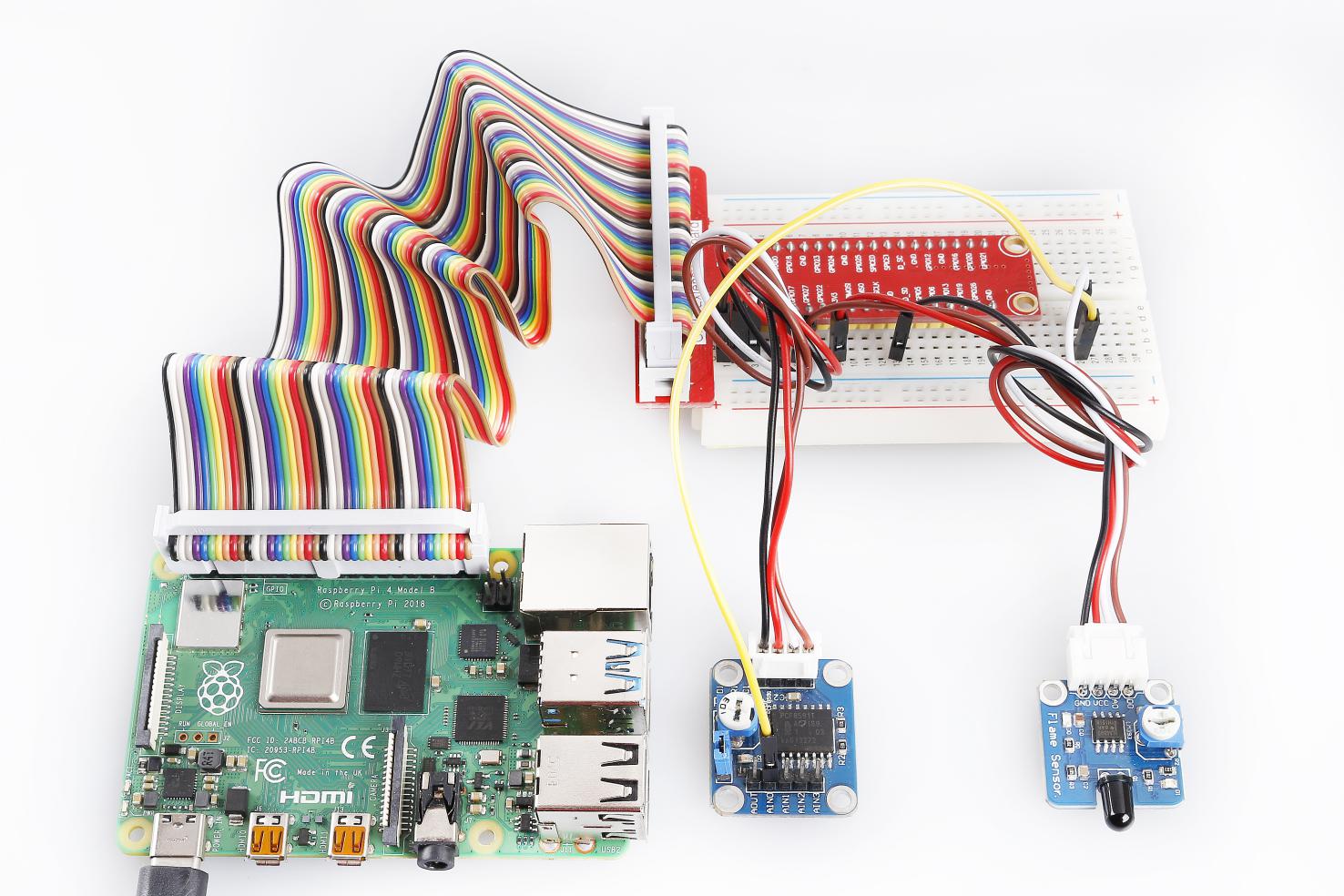Lesson 21 Flame Sensor¶
Introduction
A flame sensor (as shown below) performs detection by capturing infrared rays with specific wavelengths from flame. It can be used to detect and warn of flames.

Required Components
1 * Raspberry Pi
1 * Breadboard
1 * Flame sensor module
1 * PCF8591
1 * 4-Pin anti-reverse cable
Several Jumper wires
Experimental Principle
There are several types of flame sensors. In this experiment, we will use a far-infrared flame sensor. It can detect infrared rays with wavelength ranging from 700nm to 1000nm. A far-infrared flame probe converts the strength changes of external infrared light into current changes. And then it convert analog quantities into digital ones. In this experiment, connect pin D0 of the Flame Sensor module to a GPIO of Raspberry Pi to detect by programming whether any flame exists. The schematic diagram:

Experimental Procedures
Step 1: Build the circuit.
Raspberry Pi |
GPIO Extension Board |
PCF8591 Module |
SDA |
SDA1 |
SDA |
SCL |
SCL1 |
SCL |
3.3V |
3V3 |
VCC |
GND |
GND |
GND |
Flame Sensor |
GPIO Extension Board |
PCF8591 Module |
DO |
GPIO17 |
* |
AO |
* |
AIN0 |
VCC |
3V3 |
VCC |
GND |
GND |
GND |

For C Users:
Step 2: Change directory.
cd /home/pi/SunFounder_SensorKit_for_RPi2/C/21_flame_sensor/
Step 3: Compile.
gcc flame_sensor.c -lwiringPi
Note
If it does not work after running, or there is an error prompt wiringPi.h: No such file or directory, please refer to WiringPi to install it.
Step 4: Run.
sudo ./a.out
Code
#include <stdio.h>
#include <wiringPi.h>
#include <pcf8591.h>
#include <math.h>
#define PCF 120
#define DOpin 0
void Print(int x)
{
switch(x)
{
case 1:
printf("\n*********\n" );
printf( "* Saft~ *\n" );
printf( "*********\n\n");
break;
case 0:
printf("\n*********\n" );
printf( "* Fire! *\n" );
printf( "*********\n\n");
break;
default:
printf("\n**********************\n" );
printf( "* Print value error. *\n" );
printf( "**********************\n\n");
break;
}
}
int main()
{
int analogVal;
int tmp, status;
if(wiringPiSetup() == -1){
printf("setup wiringPi failed !");
return 1;
}
// Setup pcf8591 on base pin 120, and address 0x48
pcf8591Setup(PCF, 0x48);
pinMode(DOpin, INPUT);
status = 0;
while(1) // loop forever
{
analogVal = analogRead(PCF + 0);
printf("%d\n", analogVal);
tmp = digitalRead(DOpin);
if (tmp != status)
{
Print(tmp);
status = tmp;
}
delay (200);
}
return 0;
}
For Python Users:
Step 2: Change directory.
cd /home/pi/SunFounder_SensorKit_for_RPi2/Python/
Step 3: Run.
sudo python3 21_flame_sensor.py
Code
#!/usr/bin/env python3
import PCF8591 as ADC
import RPi.GPIO as GPIO
import time
import math
DO = 17
GPIO.setmode(GPIO.BCM)
def setup():
ADC.setup(0x48)
GPIO.setup(DO, GPIO.IN)
def Print(x):
if x == 1:
print ('')
print (' *********')
print (' * Safe~ *')
print (' *********')
print ('')
if x == 0:
print ('')
print (' *********')
print (' * Fire! *')
print (' *********')
print ('')
def loop():
status = 1
while True:
print (ADC.read(0))
tmp = GPIO.input(DO);
if tmp != status:
Print(tmp)
status = tmp
time.sleep(0.2)
if __name__ == '__main__':
try:
setup()
loop()
except KeyboardInterrupt:
pass
Now, ignite a lighter near the sensor, within the range of 80cm, and “Fire!” will be displayed on the screen. If you put out the lighter or just move the flames away from the flame sensor, “Safe~” will be displayed then.
